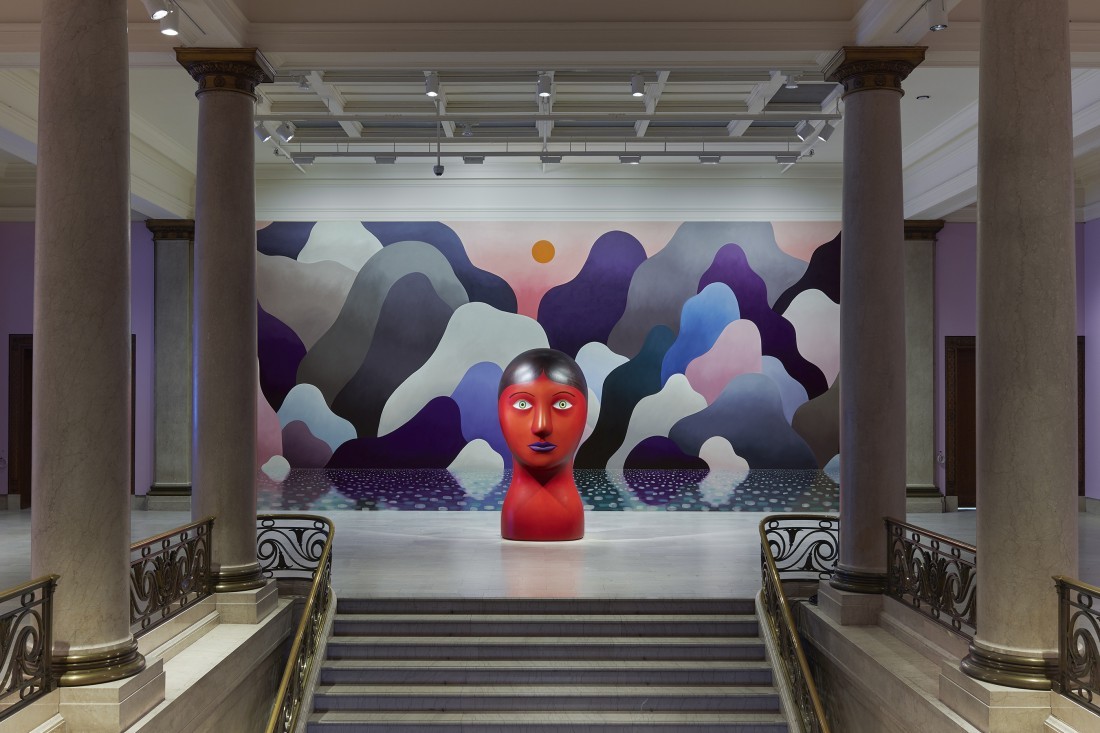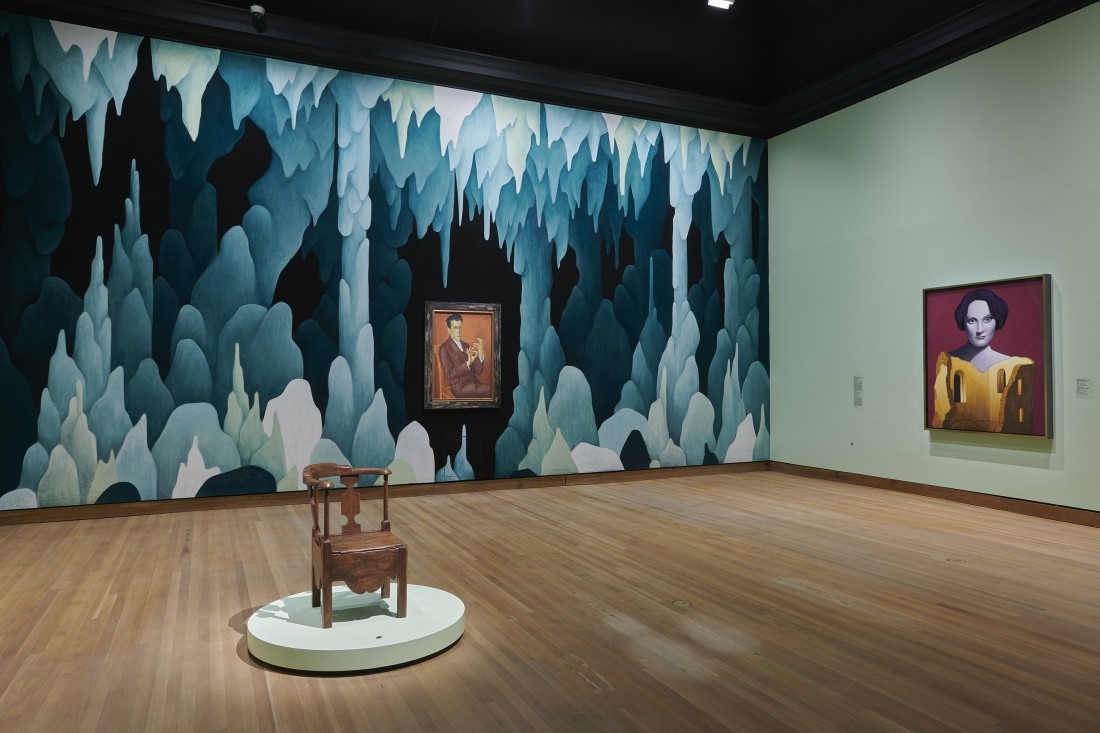Nicholas Party
When in a museum, walk slowly but keep walking. – Gertrude Stein
There’s a lot to unpack in a stroll through the immersive and multifaceted exhibition by Swiss artist Nicolas Party, “L’heure mauve.” The artist has designed an exhibition and woven his own work alongside chosen works from the museum collection, through several adjoining rooms in the Montreal Museum of Fine Arts Beaux-Arts building (now the Michal and Renata Hornstein Pavilion). A large undertaking, 180 square metres of space has been turned into a series of thematically tuned, immersive installations by Party, each space filled with dense colour and evocative wall murals where works chosen from the gallery’s collection sit beside some 50 individual works by Party himself. As an auditory enhancement, a soundtrack by Quebec musician/composer Pierre Lapointe is accessed by phone and QR code as you enter the exhibition.
Ascending the main stairs in the old pavilion, the viewer is met by a large, smoothly sculpted head painted bright red and sporting a sparingly delineated buddha-like stare (Head, 2021). It gazes over the heads of viewers as they ascend the stairs. The blank look, redolent of the deadpan expression usually painted on the face of Russian dolls, is a recurring portrait motif throughout. Behind the head is an expansive, richly coloured wall mural—a simplified mountainous landscape of undulating forms in acrylic and pastel. A rich orange dot of a sun hovers over the head as the viewer climbs, and as the mural and head reveal themselves fully on the ascent, a body of water at the bottom quarter of the mural slowly rises up from the main floor, an indicator of the immersion that’s to come. The viewer is just getting their feet wet here.

Nicholas Party, installation view, “Nicholas Party: L’heure mauve,” Montreal Museum of Fine Arts. Photo: MMFA, Jean-François Brière. © Nicholas Party. Photographs courtesy Montreal Museum of Fine Arts.
The first room accesses the soundtrack through the QR code on the wall and you enter the series of thematic spaces that reference art history: the first a dimly lit, dark green space housing a room of serpents and grottoes—a sort of birth-den of original sin—and the beginning of Party’s stroll through humanity. Of central focus is a rich wall mural of dark wood with serpentine branches. Hung centrally on it is Party’s Portrait with Mushrooms, 2019, another of the artist’s richly coloured and simply shaped pastel portraits: of a woman, her lower body a jumble of giant mushrooms, her head displaying that deadpan stare, her bright pink hair sporting moths. Works added by Party straddle and echo others in the room, like Ozias Leduc’s Day’s End, 1913, and Poussin’s Landscape with a Man Pursued by a Snake, 1637–1639. Centrally located in the space is Frank Gehry’s Wiggle Chair, 1970, a serpentine springboard of a chair in cardboard, launching the viewer into the next series of spaces. Chairs from the museum collection are also showcased throughout as a formal inflection point. They are tantalizingly present: the temptation to sit and take in a room is compelling. But we can never rest. Not lately.
Party was given carte blanche with the collection and design of the spaces. With his beginnings as a street artist, muralist and installationist, the facility with which he slides through art history, echoing forms and tackling older themes of the human condition, is immediately apparent upon first view. The further you dig, however, like the grottoes, the more you feel the need to sit down.
The largest space in the exhibition proffers landscapes from both Party and major figures of Canadian landscape painting, like Arthur Lismer, Ozias Leduc, Tom Thomson and Lawren Harris. Party’s recurring motif of trees with leafless branches was cribbed directly from Lawren Harris, whose works Party saw while visiting Montreal some years ago. “They’re like a whale skeleton or something,” he mentioned enthusiastically in conversation, and his works like the deadpan-titled Trees, 2014, echo the spareness and eerie majesty unique to the Canadian landscape. Other mountainous, muscular images encrusted with colour are displayed throughout: Party’s Sunset, 2021, keeps up an entrancing dialogue with Arthur Lismer’s Cathedral Mountain, 1928, in one section, bracketed by Party’s Les Nabis-like Sunrise, 2018. An assortment of mid-20th-century lounge chairs in the middle of the room undulate in a sort of foothill-like landscape of their own.

Nicholas Party, installation view, “Nicholas Party: L’heure mauve,” Montreal Museum of Fine Arts. Photo: MMFA, Jean-François Brière. © Nicholas Party. © Estate of Otto Dix/SOCAN (2022).
Each room riffs on the historic relationship painting has with the three basic modes: landscape, portraiture and still life. While there’s a room in the exhibition dedicated to each one, other rooms house thematic imperatives that expand and contract, depending on the artist’s exploration into issues common to humanity—rot, rebirth, ruin, devastation, vanity. An argument is made by Party for the repeated relevance of these modes in painting’s ongoing, stubborn dialogue with the world. In a press conference, he had mentioned in passing that he sees art as “time travel through objects”: smelling a Monet landscape, feeling the freeze of a mountainous Harris cold-scape. These things stick—and are the stuff of humanity’s ongoing conversation with past lives.
Giving an individual artist carte blanche and the space with which to engage fully with art historical canons and to dialogue with historical works that the artist deems important in a new manner is, in this case, innovative in intent and application: the current fondness of museums for immersive environments and collaborative efforts in exhibitions has met the predilections of an individual contemporary painter’s riffing on a museum collection of his choosing, in active collaboration with the curators.
In one room, devoted to still life, Party had selected a well-used piece from the collection, Flemish painter Frans Snyders’s Still Life with Game Suspended on Hooks, 1640s, a still life with hanging game (deer), fruit and monkeys. Party has referred to it amusingly as the “crucified Bambi” and centred it in the accompanying wall mural of repeating balls of multicoloured peach-like shapes. In a conventional museum setting, this work seems large. In Party’s setting, it is physically diminished in scale.
The question that comes up is whether an historical work seems larger in scale because of its central, more valorizing placement in a museum—which has its own traditional agenda and dedicated architecture; or whether it is diminished by placing it within an alternatively designed setting. The piece (varyingly true of the pieces in the exhibition, which tend to meld into the general design) is displaying its place in a more currently relevant dialogue: a dialogue with an individual artist’s memory, preferences and influences. Art history—as Party seems to offer here—is a more active, alive and vital thing than is normally thought. There’s no better homage than that—and worth the walk. ❚
“L’heure mauve” is exhibited at the Montreal Museum of Fine Arts, Montreal, from February 12, 2022, to October 16, 2022.
Cameron Skene is a Canadian painter and writer based in Montreal.

